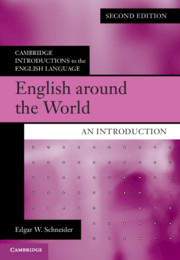130 results
Lexicosemantic diffusion in World Englishes: variable meaning–form relations in prospective verbs
-
- Journal:
- English Language & Linguistics / Volume 27 / Issue 4 / December 2023
- Published online by Cambridge University Press:
- 24 May 2023, pp. 719-748
-
- Article
-
- You have access
- Open access
- HTML
- Export citation
18 - The Geographical and Demographic Expansion of English
- from Part Four - Emergence and Spread of Some European Languages
-
-
- Book:
- The Cambridge Handbook of Language Contact
- Published online:
- 02 June 2022
- Print publication:
- 30 June 2022, pp 583-610
-
- Chapter
- Export citation
Hans-Jörg Schmid, The dynamics of the linguistic system: Usage, conventionalization, and entrenchment. Oxford: Oxford University Press, 2020. Pp. xxiii + 397. ISBN 9780198814771.
-
- Journal:
- English Language & Linguistics / Volume 26 / Issue 1 / March 2022
- Published online by Cambridge University Press:
- 11 November 2021, pp. 209-216
-
- Article
- Export citation
2 - The Emergence of Global Languages
-
-
- Book:
- English and Spanish
- Published online:
- 17 September 2021
- Print publication:
- 30 September 2021, pp 10-30
-
- Chapter
- Export citation
All Things New in Singapore: On creativity, complexity, and usage associations in Englishes: What a simple phrase can teach us on linguistic creativity and on how language works
-
- Journal:
- English Today / Volume 39 / Issue 1 / March 2023
- Published online by Cambridge University Press:
- 19 July 2021, pp. 24-34
- Print publication:
- March 2023
-
- Article
- Export citation
1 - Calling Englishes As Complex Dynamic Systems: Diffusion and Restructuring
- from Part I - Pooling Perspectives
-
-
- Book:
- Language Change
- Published online:
- 17 December 2020
- Print publication:
- 03 December 2020, pp 15-43
-
- Chapter
- Export citation
Contents
- from Chapter 1 - Introduction
-
- Book:
- English around the World
- Published online:
- 25 September 2020
- Print publication:
- 30 July 2020, pp 1-14
-
- Chapter
- Export citation
Appendix 2: A List of Guiding Questions on English in Any Specific Region
-
- Book:
- English around the World
- Published online:
- 25 September 2020
- Print publication:
- 30 July 2020, pp 253-255
-
- Chapter
- Export citation
Chapter 6 - Missionaries, Merchants, and More: English Is Useful, English Is Ours
-
- Book:
- English around the World
- Published online:
- 25 September 2020
- Print publication:
- 30 July 2020, pp 142-198
-
- Chapter
- Export citation
Contents
- from Chapter 7 - Language Development: A General Perspective
-
- Book:
- English around the World
- Published online:
- 25 September 2020
- Print publication:
- 30 July 2020, pp 199-220
-
- Chapter
- Export citation
Contents
- from Chapter 3 - Historical Background
-
- Book:
- English around the World
- Published online:
- 25 September 2020
- Print publication:
- 30 July 2020, pp 46-67
-
- Chapter
- Export citation
Texts and Audio Samples
-
- Book:
- English around the World
- Published online:
- 25 September 2020
- Print publication:
- 30 July 2020, pp xii-xiv
-
- Chapter
- Export citation
Preface to the Second Edition
-
- Book:
- English around the World
- Published online:
- 25 September 2020
- Print publication:
- 30 July 2020, pp xv-xvi
-
- Chapter
- Export citation

English around the World
- An Introduction
-
- Published online:
- 25 September 2020
- Print publication:
- 30 July 2020
-
- Textbook
- Export citation
Index
-
- Book:
- English around the World
- Published online:
- 25 September 2020
- Print publication:
- 30 July 2020, pp 279-284
-
- Chapter
- Export citation
Chapter 4 - Language Crossing an Ocean: Old World and New World
-
- Book:
- English around the World
- Published online:
- 25 September 2020
- Print publication:
- 30 July 2020, pp 68-117
-
- Chapter
- Export citation
Appendix 3: How to Research World Englishes: Sources and Methodology
-
- Book:
- English around the World
- Published online:
- 25 September 2020
- Print publication:
- 30 July 2020, pp 256-259
-
- Chapter
- Export citation
Chapter 9 - Conclusion
-
- Book:
- English around the World
- Published online:
- 25 September 2020
- Print publication:
- 30 July 2020, pp 247-249
-
- Chapter
- Export citation
Chapter 2 - Basic Notions
-
- Book:
- English around the World
- Published online:
- 25 September 2020
- Print publication:
- 30 July 2020, pp 15-45
-
- Chapter
- Export citation
Contents
- from Chapter 4 - Language Crossing an Ocean: Old World and New World
-
- Book:
- English around the World
- Published online:
- 25 September 2020
- Print publication:
- 30 July 2020, pp 68-117
-
- Chapter
- Export citation

